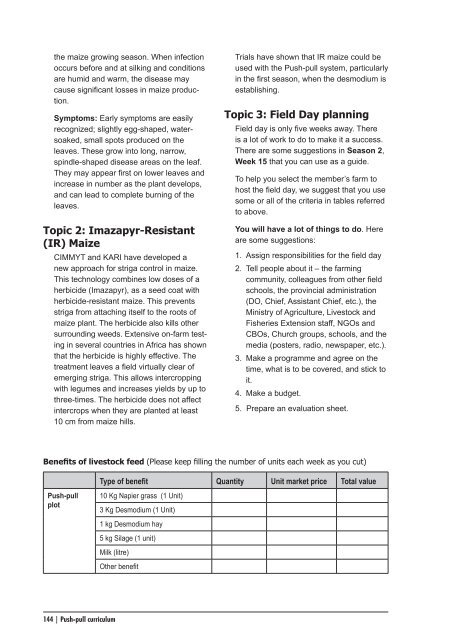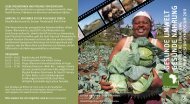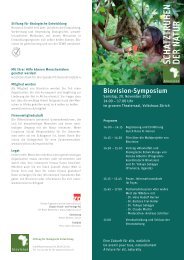Curriculum (PDF) - Biovision
Curriculum (PDF) - Biovision
Curriculum (PDF) - Biovision
Create successful ePaper yourself
Turn your PDF publications into a flip-book with our unique Google optimized e-Paper software.
the maize growing season. When infection<br />
occurs before and at silking and conditions<br />
are humid and warm, the disease may<br />
cause significant losses in maize production.<br />
Symptoms: Early symptoms are easily<br />
recognized; slightly egg-shaped, watersoaked,<br />
small spots produced on the<br />
leaves. These grow into long, narrow,<br />
spindle-shaped disease areas on the leaf.<br />
They may appear first on lower leaves and<br />
increase in number as the plant develops,<br />
and can lead to complete burning of the<br />
leaves.<br />
Topic 2: Imazapyr-Resistant<br />
(IR) Maize<br />
CIMMYT and KARI have developed a<br />
new approach for striga control in maize.<br />
This technology combines low doses of a<br />
herbicide (Imazapyr), as a seed coat with<br />
herbicide-resistant maize. This prevents<br />
striga from attaching itself to the roots of<br />
maize plant. The herbicide also kills other<br />
surrounding weeds. Extensive on-farm testing<br />
in several countries in Africa has shown<br />
that the herbicide is highly effective. The<br />
treatment leaves a field virtually clear of<br />
emerging striga. This allows intercropping<br />
with legumes and increases yields by up to<br />
three-times. The herbicide does not affect<br />
intercrops when they are planted at least<br />
10 cm from maize hills.<br />
144 | Push-pull curriculum<br />
Trials have shown that IR maize could be<br />
used with the Push-pull system, particularly<br />
in the first season, when the desmodium is<br />
establishing.<br />
Topic 3: Field Day planning<br />
Field day is only five weeks away. There<br />
is a lot of work to do to make it a success.<br />
There are some suggestions in Season 2,<br />
Week 15 that you can use as a guide.<br />
To help you select the member’s farm to<br />
host the field day, we suggest that you use<br />
some or all of the criteria in tables referred<br />
to above.<br />
You will have a lot of things to do. Here<br />
are some suggestions:<br />
1. Assign responsibilities for the field day<br />
2. Tell people about it – the farming<br />
community, colleagues from other field<br />
schools, the provincial administration<br />
(DO, Chief, Assistant Chief, etc.), the<br />
Ministry of Agriculture, Livestock and<br />
Fisheries Extension staff, NGOs and<br />
CBOs, Church groups, schools, and the<br />
media (posters, radio, newspaper, etc.).<br />
3. Make a programme and agree on the<br />
time, what is to be covered, and stick to<br />
it.<br />
4. Make a budget.<br />
5. Prepare an evaluation sheet.<br />
Benefits of livestock feed (Please keep filling the number of units each week as you cut)<br />
Push-pull<br />
plot<br />
Type of benefit Quantity Unit market price Total value<br />
10 Kg Napier grass (1 Unit)<br />
3 Kg Desmodium (1 Unit)<br />
1 kg Desmodium hay<br />
5 kg Silage (1 unit)<br />
Milk (litre)<br />
Other benefit




